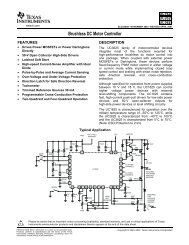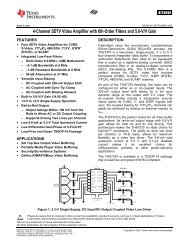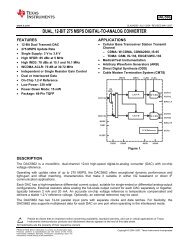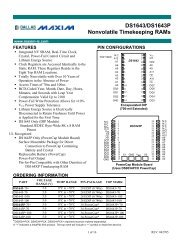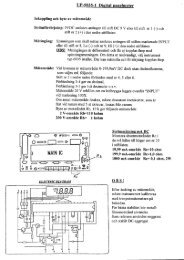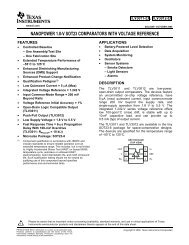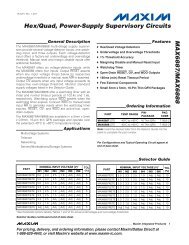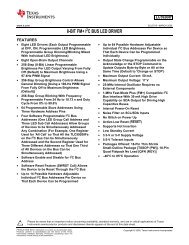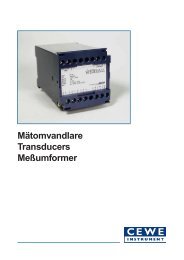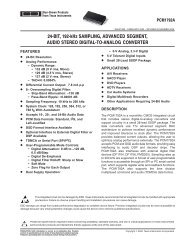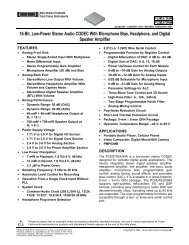Single-Chip Low Power RF Transceiver for Narrowband Systems ...
Single-Chip Low Power RF Transceiver for Narrowband Systems ...
Single-Chip Low Power RF Transceiver for Narrowband Systems ...
Create successful ePaper yourself
Turn your PDF publications into a flip-book with our unique Google optimized e-Paper software.
The DEC_DIV[2:0] bits in the FILTER<br />
register control the receiver channel filter<br />
bandwidth. The 6 dB bandwidth is given<br />
by:<br />
ChBW = 307.2 / (DEC_DIV + 1) [kHz]<br />
where the IF frequency is set to 307.2<br />
kHz. Table 18 shows the available channel<br />
filter bandwidths.<br />
There is a tradeoff between selectivity as<br />
well as sensitivity and accepted frequency<br />
tolerance. In applications where larger<br />
frequency drift is expected, the filter<br />
CC1021<br />
bandwidth can be increased, but with<br />
reduced adjacent channel rejection (ACR)<br />
and sensitivity.<br />
Filter bandwidth FILTER.DEC_DIV[2:0]<br />
[kHz]<br />
[decimal(binary)]<br />
38.4 7 (111b)<br />
43.9 6 (110b)<br />
51.2 5 (101b)<br />
61.4 4 (100b)<br />
76.8 3 (011b)<br />
102.4 2 (010b)<br />
153.6 1 (001b)<br />
307.2 0 (000b)<br />
12.3. Demodulator, Bit Synchronizer and Data Decision<br />
The block diagram <strong>for</strong> the demodulator,<br />
data slicer and bit synchronizer is shown<br />
in Figure 13. The built-in bit synchronizer<br />
synchronizes the internal clock to the<br />
incoming data and per<strong>for</strong>ms data<br />
decoding. The data decision is done using<br />
over-sampling and digital filtering of the<br />
incoming signal. This improves the<br />
reliability of the data transmission. Using<br />
the synchronous modes simplifies the<br />
data-decoding task substantially.<br />
The recommended preamble is a<br />
‘010101…’ bit pattern. The same bit<br />
pattern should also be used in Manchester<br />
mode, giving a ‘011001100110…‘chip’<br />
pattern. This is necessary <strong>for</strong> the bit<br />
synchronizer to synchronize to the coding<br />
correctly.<br />
The data slicer does the bit decision.<br />
Ideally the two received FSK frequencies<br />
are placed symmetrically around the IF<br />
frequency. However, if there is some<br />
frequency error between the transmitter<br />
and the receiver, the bit decision level<br />
should be adjusted accordingly. In CC1021<br />
this is done automatically by measuring<br />
the two frequencies and use the average<br />
value as the decision level.<br />
The digital data slicer in CC1021 uses an<br />
average value of the minimum and<br />
maximum frequency deviation detected as<br />
the comparison level. The RXDEV_X[1:0]<br />
and RXDEV_M[3:0] in the<br />
AFC_CONTROL register are used to set<br />
the expected deviation of the incoming<br />
Table 18. Channel filter bandwidth<br />
signal. Once a shift in the received<br />
frequency larger than the expected<br />
deviation is detected, a bit transition is<br />
recorded and the average value to be<br />
used by the data slicer is calculated.<br />
The minimum number of transitions<br />
required to calculate a slicing level is 3.<br />
That is, a 010 bit pattern (NRZ).<br />
The actual number of bits used <strong>for</strong> the<br />
averaging can be increased <strong>for</strong> better data<br />
decision accuracy. This is controlled by<br />
the SETTLING[1:0] bits in the<br />
AFC_CONTROL register. If RX data is<br />
present in the channel when the RX chain<br />
is turned on, then the data slicing estimate<br />
will usually give correct results after 3 bit<br />
transitions. The data slicing accuracy will<br />
increase after this, depending on the<br />
SETTLING[1:0] bits. If the start of<br />
transmission occurs after the RX chain<br />
has turned on, the minimum number of bit<br />
transitions (or preamble bits) be<strong>for</strong>e<br />
correct data slicing will depend on the<br />
SETTLING[1:0] bits.<br />
The automatic data slicer average value<br />
function can be disabled by setting<br />
SETTLING[1:0] = 00. In this case a<br />
symmetrical signal around the IF<br />
frequency is assumed.<br />
The internally calculated average FSK<br />
frequency value gives a measure <strong>for</strong> the<br />
frequency offset of the receiver compared<br />
to the transmitter. This in<strong>for</strong>mation can<br />
also be used <strong>for</strong> an automatic frequency<br />
SWRS045B Page 31 of 89



